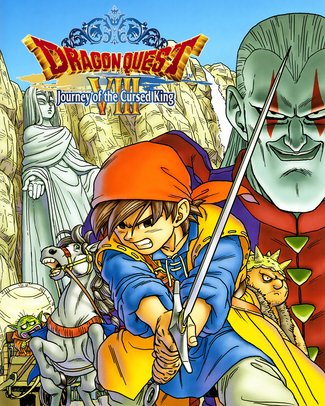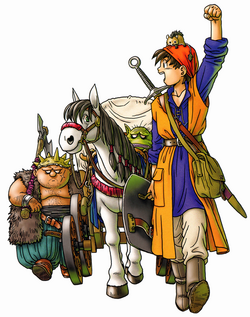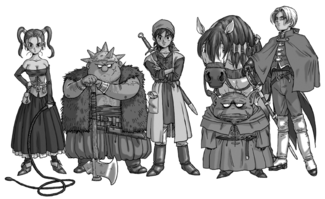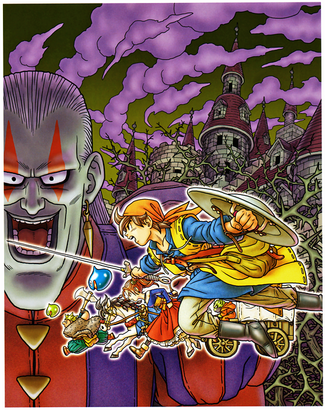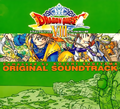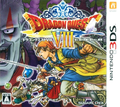Dragon Quest VIII: Journey of the Cursed King
| Main series games | |
|---|---|
| Journey of the Cursed King | |
| Developer(s) | Level-5 |
| Publisher(s) | Square Enix |
| Designer(s) | Yūji Horii |
| Artist(s) | Akira Toriyama |
| Composer(s) | Kōichi Sugiyama |
| Series | Dragon Quest |
| Aspect ratio | 16:9 / 4:3 |
| Native resolution | 480i (SDTV) |
| Platform(s) | Sony PlayStation 2 Nintendo 3DS |
| Release date(s) | JP November 27, 2004 NA November 15, 2005 AUS April 12, 2006 EU April 13, 2006 NA January 20, 2017 EU January 20, 2017 |
| Genre(s) | Console role-playing game |
| Mode(s) | Single-player |
| Rating(s) | CERO: All ages ESRB: T (Teen) OFLC: PG PEGI: 12+ USK: 6 |
| Media | DVD |
| Input methods | DualShock 2 |
Dragon Quest VIII (ドラゴンクエストVIII 空と海と大地と呪われし姫君 Dragon Quest VIII Sora to Umi to Daichi to Norowareshi Himegimi, Dragon Quest VIII: The Sky, the Ocean, the Earth, and the Cursed Princess) is the eighth installment in the Dragon Quest series, developed by Level-5 and published by Square Enix for the PlayStation 2 video game console. It was also later released for the Nintendo 3DS in 2015.
Plot
Characters
Playable Characters
- Hero - The hero is a royal guard of Trodain, who journeys with King Trode to hunt down Dhoulmagus and make him pay for his crimes. His pet mouse, Munchie, usually rides in his right coat pocket.
- Yangus - Yangus is a former bandit who journeys with the Hero and King Trode. Like the hero, he is a party member from the start of the game.
- Jessica - A voluptuous, short-tempered, and tomboyish sorceress born to a wealthy family in the town of Alexandria, and the third party member. She seeks to avenge her brother Alistair, who is slain by Dhoulmagus.
- Angelo - Angelo is one of Maella Abbey's Templar Knights and the fourth party member. Though unable to live with the strict moral code of the Templars, with his lust for gambling and women, he is faithfully devoted to Abbot Francisco.
Other Characters
- King Trode - King Trode is the King of Trodain, and the titular character of Dragon Quest VIII: Journey of the Cursed King. He was transformed into a toad-like creature by the evil wizard Dhoulmagus, and is trying to find a way to lift the curse upon him. During parts of the game, if you press the Select button, King Trode will give you helpful advice.
- Princess Medea - Medea is the daughter of King Trode. She was turned into a horse when her father was cursed by Dhoulmagus. She travels with the heroes by pulling the cart with their supplies. She and the Hero are close childhood friends.
- Marcello - Marcello is the captain of the Templar Knights who guard the Abbot with their lives. However, Marcello wants more power than was offered, and after he takes over following the Abbot's death, he becomes a partner to High Priest Rolo. With this opening, the resulting events that Marcello causes will set the stage for the fate of the world to be decided.
- Sir Leopold - He is the spoiled dog of the great magician Dominico. Leopold is let out of his cage by the mistake of a servant, and after the previous wielder of the Sceptre drops it, Leopold picks it up and is taken over by Rhapthorne.
- Dhoulmagus - Dhoulmagus is a jester who, in order to get revenge on those who insulted him, stole a magical sceptre from Trodain Castle. However, when he attempted to unleash its power, it overwhelmed him, and allowed Rhapthorne to take over his body.
- Lord Rhapthorne - Lord Rhapthorne is the main antagonist who is heard, but isn't seen until the end of the game. His spirit was trapped in the Trodain sceptre that Dhoulmagus possessed in the beginning of the game. Lord Rhapthorne took control of whoever possessed the sceptre which was first Dhoulmagus, then Jessica, then a fearsome pet dog named Sir Leopold until he killed each heir of the seven sages to release his energy and give himself his own body.
New Features
Player conveniences
- Random encounters are suppressed as long as the party is on a road.
- There is an automap feature in dungeons, and complete maps of all towns. The locations and contents of chests are marked on the map. Also, it is possible to browse the inventory of the shops while looking at the town map.
- Party conversations return from the previous installment, but it is now possible to either select which party member to talk to, or cycle through them in order.
- All items now have specific icons and illustrations, which can be viewed in the menu.
- The player can now select how long they wish to stay at an Inn, changing the time of day.
- In the event of a full party wipe out, all characters are automatically revived at the last church the game was saved at.
Battle refinements
- Individual monsters within groups can now be targeted.
- Wisdom now improves the power of offensive spells, addressing the infamous schism between the usefulness of magic and skills in VI and VII.
- A new command has been added to the battle menu, Intimidate. The purpose of this option is to end battles quickly by driving monsters off, and each terrorized beast still has a chance to drop an item. Success is dependent on the lead character's level against the monster's, even if a character not in the lead is shown doing the intimidating.
Alchemy
At a certain point in the early game, the party receives an Alchemy Pot. This device can be used to combine two items into a third (usually more powerful) item following various recipes. The combination takes a certain amount of time, depending on the power of the combined item and the level of the pot. This "time" only advances as the wagon moves, on the overworld. Later in the game, the pot is upgraded to hold three items, allowing additional, even more powerful recipes.
An invalid recipe will be rejected immediately without consuming the items, allowing the player to experiment to find new recipes. In the Bonus Dungeon, the player gains a pot that can mix items instantly.
New recipes (or clues to new recipes) are revealed in various books and scraps of paper found throughout the game. All recipes the player has discovered are listed in a "recipe book" accessed through the alchemy menu; recipes which are only partially known (from a clue) will have some item names replaced with "????."
Skill system
In addition to learning spells when reaching a certain level, characters are now able to attain new abilities by allocating skill points into one of five categories. The types of skills are the character's three favored weapon, unarmed combat, and the character's innate personality. Skill points are awarded upon leveling up, or when using a Seed of Skill], and must be used immediately or the menu will not close.
Because skills are now tied to specific weapon groups, only the abilities learned by developing a character's personality can be used at any time--all other skills are locked to that specific type of weapon. For example, Jessica may use Puff-Puff if she is equipped with a whip, but not Sudden Death.
Tension system
There is a new Dragon Ball-inspired tension system, allowing combatants to spend a turn building up "tension," which will increase the power level of their next attack or spell. Tension can be built up repeatedly, increasing attack power by up to seven times. There is a new party AI option to focus on using high-tension attacks, replacing the old "Leave it to me" option. Attempting to reach the fourth, "super-high tension" state has a 2/3rds chance of failure. Also, some monsters are able to instantly reach the third stage of tension, and will then repeatedly attempt to reach the super-high level.
Other changes
- Characters are shown holding their equipped weapons, posture changing on the type of weapon and their state of health and status. In a few cases the character's displayed clothing will change to reflect their equipment, seen most notably with Jessica's outfits.
- The battle screens are shown in a dynamic view, with shifting camera angles to display the current combatant and the action being performed. The party appears in the battle screen, unlike previous installments. At the end of the battle, an animation of the surviving party members putting away their weapons is played.
- The buildings in a town are visible even from the overworld view.
- The day-night cycle of games III, IV, and V is restored. Time now passes even in towns, and the party can use an inn to switch from day to night, as well as vice-versa. Thus, there is no longer a Night light, or related spells.
- Style has been removed.
- Characters cannot be renamed.
Vehicles
Vehicles are shown at their actual size, and the world map is scaled down appropriately when they are in use. The ship has a bridge which it uses to dock with the land, and its altitude can be changed to match the shorter cliffs, if necessary.
The other available vehicles are a Sabrecat steed (summoned with a magic bell), which moves much faster than the hero, allowing the party to move further between random encounters (although they still occur at the same rate), and a stone, which allows the party to turn into birds.
Although the party has a wagon throughout the game, it has no effect on gameplay, since the party is essentially fixed throughout the game. Also, it is not normally shown on the display, only appearing during cutscenes or the Party Chat screen.
The player can also use the Godbird Soulstone, which can be obtained later, enabling flight.
Development
Like the other games in the series, Dragon Quest VIII's designers include Yuji Horii as scenario director, Akira Toriyama as the art designer, and Koichi Sugiyama as the music composer.
Unlike the original Japanese version, the North American and European localizations of the game mark a departure from previous Dragon Quest titles, due to the inclusion of voice acting in certain parts of the adventure pertaining to the advancement of the storyline. The game nevertheless retains the series' tradition of allowing the player to name the lead character, reconciling the two by having the voice acting script skip all incidences of the hero's name (e.g., the line, "Okay, [Hero], my boy..." appears onscreen, while the voice acting says, "Okay, my boy..."), and occasionally replacing the name with Yangus' nickname for the hero, "guv'" (as in "governor," pronounced with a Cockney accent). In addition, small changes, such as the removal of the traditional 8-bit sound effects that accompany attacks, and magic abilities, were made. Despite other games in the series being edited during localization for North America, Dragon Quest VIII has no editing in it. The English translation is credited to Plus Alpha Translations and AltJapan.
Several characters from previous Dragon Quest games make a cameo appearance, among which are the Fighter and Warrior from Dragon Quest III; Ragnar, Healie, and Torneko (here called Torneko Taloon, a combination of the names by which he's known in Japan and America) from Dragon Quest IV; and the legendary bird Ramia from Dragon Quest III. There is even an allusion to the Dracolord (Dragonlord) from Dragon Quest I present during the course of the game.
Localization
Dragon Quest VIII: Journey of the Cursed King was released in North America on November 15, 2005, and shipped with a playable Final Fantasy XII demo disc. Additions and changes to the North American version of Dragon Quest VIII include: voice acting, new animations, enhanced music and sound effects, additional spells and attacks, and a new menu interface. It was also the first game in the Dragon Quest series to bear the original, Japanese "Dragon Quest" name (rather than "Dragon Warrior") in North America. Dragon Quest's North American name was changed, due to a trademark conflict with the role-playing game DragonQuest, which was published by wargame publisher Simulations Publications in the 1980s until the company's bankruptcy in 1982 and purchase by TSR, Inc., which then published it as an alternate pen-and-paper RPG line to Dungeons & Dragons until 1987.
In 2003, Square Enix registered the Dragon Quest trademark in the US, making the "Dragon Warrior" name obsolete. Thus, this instalment of the series was the first after 2003 to be released outside of Japan and to receive the word "Quest" in its title.
A demo disc for Dragon Quest VIII was released in America during the fall of 2005 through certain venues, including Shonen Jump magazine. Dragon Quest VIII is also the first flagship Dragon Quest game to be released in Europe. It was released in Europe on April 13, 2006, under the title Dragon Quest: The Journey of the Cursed King, dropping the sequel number. Unlike the North American version, the European version does not contain a Final Fantasy XII demo.
Trivia
- VIII is the first, and so far only, entry in the main series to begin with a battle sequence.
- VIII enjoyed a relatively smooth development process compared to its peers, being the only game to never be delayed from the initial announcement.
Gallery
